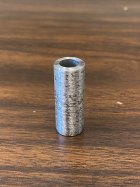You are using an out of date browser. It may not display this or other websites correctly.
You should upgrade or use an alternative browser.
You should upgrade or use an alternative browser.
G10 Pillars - Yes. Good.
- Thread starter LVLAaron
- Start date
AlNyhus
Silver $$ Contributor
Measuring the compression of a 5/8"× 1.250" length 6061-T6 pillar with a 5/16" I.D., there was no compressive loss in length until reaching the 80 lbs/ft.It would seem the primary benefit of the G-10, over a cast, fiberglass reinforced pillar, would be reduced compressibility, since it is already compressed.
The use of escutcheons on BR stocks was a 'must' in the early days of foam filled shells as it spread the load out over the bottom of the stock. With todays filler materials, that's a non-issue.Regarding escutcheons and pillars: the pillar is essentially part of the stock. The escutcheon is a means to transfer compression forces to the stock. If the escutcheon is glued in place, it becomes part of the stock. Whether or not this alters the function in any way, I can't say. WH
Pardon the slight veer off topic.
WSnyder
Silver $$ Contributor
Speedy’s reasoning is that it is less reactive to temperature changes. I think that is his main reason for using it, not that it is any easier to work with. I believe he states basically that in the posted video. I’ve seen it stated elsewhere from him as well. It’s likely true but I have no idea if it matters.Is there a reason, other than easier to work with, I would want to use G10 instead of 304 stainless?
WeightIs there a reason, other than easier to work with, I would want to use G10 instead of 304 stainless?
The reasons for using the G10 would seem to be the same reasons I have always used for casting glass reinforced pillars, weight, thermal stability, and adhesion. The use of something like this, saves the casting. It would be interesting to test compressibility of G10 compared to aluminum. I would suspect it is much more compressible; just as most plastics would be, but possibly less compressible than cast epoxy/glass.
Al, my early (1976 to 1980) Brown precision and Lee Six stocks were solid in the action area. Nonetheless, I always used the same cast pillar technique as I did in wood. I did know of stocks which were just foam filled but never had one. I still have one brand new Lee Six stock which I ordered in 1978. It is solid in the action area. WH
Al, my early (1976 to 1980) Brown precision and Lee Six stocks were solid in the action area. Nonetheless, I always used the same cast pillar technique as I did in wood. I did know of stocks which were just foam filled but never had one. I still have one brand new Lee Six stock which I ordered in 1978. It is solid in the action area. WH
You’re too modest.Stock comes mostly inletted, I just clean it up, get it straight, and make room for mud
WSnyder
Silver $$ Contributor
They are very similar in compressibility. 6061 I find listed as 45K psi and G-10 I find listed up to as high as 66K psi but versions as low as 35K psi.It would be interesting to test compressibility of G10 compared to aluminum. I would suspect it is much more compressible;
xr650rRider
Silver $$ Contributor
First of this video, you can see some of the G10 pillars from nearly 15 years ago.
eddief
Silver $$ Contributor
I've used a multitude of different materials for pillars over the years. Never really seen a difference as long as they are installed correctly. Sandblast the outside of your aluminum or steel pillars if you have that option, then no grooves are needed and the bedding will adhere very well.
Upgrades & Donations
This Forum's expenses are primarily paid by member contributions. You can upgrade your Forum membership in seconds. Gold and Silver members get unlimited FREE classifieds for one year. Gold members can upload custom avatars.

Click Upgrade Membership Button ABOVE to get Gold or Silver Status.
You can also donate any amount, large or small, with the button below. Include your Forum Name in the PayPal Notes field.
To DONATE by CHECK, or make a recurring donation, CLICK HERE to learn how.

Click Upgrade Membership Button ABOVE to get Gold or Silver Status.
You can also donate any amount, large or small, with the button below. Include your Forum Name in the PayPal Notes field.
To DONATE by CHECK, or make a recurring donation, CLICK HERE to learn how.










